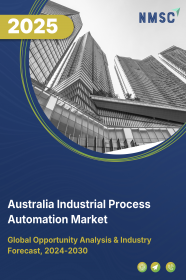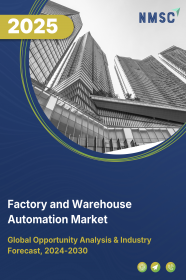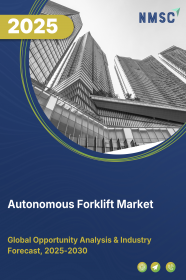
Australia Industrial Process Automation Market by Component {MES (Hardware, Software, Services); DCS (Hardware, Software, Services); PLC (Hardware, Software, Services); SCADA (Hardware, Software, Services); Field Instruments; Industrial Robots; Human Machine Interface; Industrial PCs; Process Analyzers & Drives} and by End User (Oil & Gas, Chemicals & Refining, Energy & Power, Pulp & Paper, Metals & Mining, Pharma, & Others) – Global Opportunity Analysis and Industry Forecast, 2025–2030
Industry: Semiconductor & Electronics | Publish Date: 31-Oct-2025 | No of Pages: 159 | No. of Tables: 121 | No. of Figures: 66 | Format: PDF | Report Code : SE997
Industry Outlook
The Australia Industrial Process Automation Market size was valued at USD 423.1 million in 2024 and is projected to grow to USD 463.6 million by 2025. Additionally, the industry is expected to continue its growth trajectory, reaching USD 648.6 million by 2030, with a CAGR of 7.38% from 2025 to 2030.
The Australia industrial process automation market is being propelled by the adoption of Industry 4.0 technologies and strong government investments that foster innovation, efficiency, and competitiveness, positioning the country as a modern manufacturing hub. Smart sensors, real-time analytics, and interconnected systems enable predictive operations and agility, while public funding, tax incentives, and research collaborations drive technological advancement. However, integration challenges with legacy systems, high implementation costs, and workforce skill shortages restrain adoption, particularly among SMEs. Looking ahead, the integration of AI and ML offers significant opportunities by enabling predictive maintenance, optimizing workflows, and enhancing quality control, further strengthening Australia’s role in advanced industrial automation.
Industry 4.0 Adoption Accelerates the Australia Industrial Process Automation Market Growth in Australia
The adoption of Industry 4.0 in Australia is playing a pivotal role in accelerating industrial process automation. Through the integration of smart sensors, real-time data analytics, and interconnected systems, industries are moving toward highly efficient, intelligent, and predictive operations. These technologies allow companies to monitor equipment health, anticipate failures, and optimize workflows, which minimizes production downtime and reduces maintenance costs. Beyond operational improvements, Industry 4.0 fosters a more agile and flexible production environment that quickly adapt to changing market demands. This digital transformation not only enhances industrial competitiveness within Australia but also contributes to global economic growth, strengthening the country’s position as a technologically advanced manufacturing hub.
Government Investments Drive Technological Advancement
Government investment in technology industries is a major driver of the Australia industrial automation market growth. Public funding initiatives, tax incentives, and collaborative research programs are actively encouraging industries to adopt advanced automation systems. These investments accelerate the development of innovative solutions, promote local manufacturing capabilities, and support the transition toward modernized, data-driven operations. By prioritizing infrastructure upgrades and fostering partnerships between academia, industry, and technology providers, government policies create an ecosystem that supports sustainable growth. This environment not only enhances productivity and operational efficiency but also positions Australian industries to compete effectively in global markets by embracing next-generation automation technologies.
System Integration Challenges Restrain Market Growth
Despite the benefits of automation, the integration of new technologies with existing legacy systems remains a key challenge in Australia. Many businesses, particularly small and medium-sized enterprises, face technical and financial hurdles in aligning modern automation solutions with outdated infrastructure. These challenges lead to increased implementation costs, longer deployment timelines, and operational disruptions during the transition phase. Furthermore, the shortage of skilled professionals capable of managing system integration adds to the complexity, slowing adoption rates. As a result, integration difficulties hinder the scalability of automation projects and limit the overall pace of market expansion in the country.
AI and ML Integration Unlocks Future Growth in Industrial Process Automation
The integration of artificial intelligence (AI) and machine learning (ML) offers significant future opportunities for the industrial process automation market in Australia. These technologies enable predictive maintenance, optimize workflows, and support real-time decision-making with minimal human involvement. AI-driven systems analyze vast datasets to detect inefficiencies, enhance quality control, and reduce operational risks, while ML algorithms continuously improve performance through adaptive learning. According to the Association for Advancing Automation (A3), AI and ML applications will help industries relieve workforce burdens by automating repetitive tasks and streamlining production oversight. This integration not only drives cost savings and productivity but also fosters innovation, precision, and customization in manufacturing, positioning Australia as a leader in advanced industrial automation.
Competitive Landscape
The promising players operating in Australia industrial process automation industry include Siemens AG, Mitsubishi Electric Corporation, Schneider Electric SE, Honeywell International Inc., ABB Ltd., Toshiba Corporation, Emerson Electric Co., Rockwell Automation Inc., Omron Corporation, Valmet OYJ, Yokogawa Electric Corporation, Endress+Hauser, Dwyer Instruments Inc., Fuji Electric Co., Ltd., and FESTO and others.
Australia Industrial Process Automation Market Key Segments
By Component
-
Manufacturing Execution Systems
-
Hardware
-
Software
-
Services
-
-
Distributed Control Systems
-
Hardware
-
Software
-
Services
-
-
Programmable Logic Control
-
Hardware
-
Software
-
Services
-
-
Supervisory Control and Data Acquisition (SCADA)
-
Hardware
-
Software
-
Services
-
-
Field Instruments
-
Industrial Robots
-
Human Machine Interface
-
Industrial PCS
-
Process Analyzers & Drives
By End-User
-
Oil & Gas
-
Chemical & Refining
-
Energy & Power
-
Pulp & Paper
-
Metals & Mining
-
Pharma
-
Cement & Glass
-
Others
Key Players
-
Siemens AG
-
Mitsubishi Electric Corporation
-
Schneider Electric SE
-
ABB Ltd.
-
Toshiba Corporation
-
Rockwell Automation, Inc.
-
Omron Corporation
-
Valmet Oyj
-
Yokogawa Electric Corporation
-
Endress+Hauser AG
-
Dwyer Instruments Inc.
-
Fuji Electric Co., Ltd.
-
FESTO
Report Scope and Segmentation
|
Parameters |
Details |
|
Market Size Value in 2025 |
USD 463.6 million |
|
Revenue Forecast in 2030 |
USD 648.6 million |
|
Value Growth Rate |
CAGR of 7.38%from 2025 to 2030 |
|
Analysis Period |
2024–2030 |
|
Base Year Considered |
2024 |
|
Forecast Period |
2025–2030 |
|
Market Size Estimation |
Million (USD) |
|
Growth Factors |
|
|
Companies Profiled |
15 |
|
Market Share |
Available for 10 companies |
|
Customization Scope |
Free customization (equivalent to up to 80 working hours of analysts) after purchase. Addition or alteration to country, regional, and segment scope. |
|
Pricing and Purchase Options |
Avail customized purchase options to meet your exact research needs. |

















 Speak to Our Analyst
Speak to Our Analyst
























